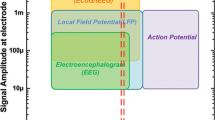Abstract
Neural interfacing devices enable new therapies based on neuromodulation for diseases and conditions, such as Parkinson’s disease and dystonia, which currently cannot be treated adequately with medication alone, thus potentially improving the quality of life for patients suffering from these diseases. It is well understood that like any other implantable medical device (IMD), neural interfacing devices need to be wireless and minimally invasive. This objective can be achieved by developing highly miniaturized implants with new distributed system architectures that in turn require novel circuit topologies. This chapter presents circuit design concepts, wireless operation strategies, and system-level integration of mm-sized wirelessly powered distributed neural interfacing IMDs for a particularly challenging subset of neuromodulation devices that can be used for untethered and battery-free optogenetic neuromodulation. Spanning from the integrated circuit (IC) design to the mm-sized implant microassembly and to the focused wireless power delivery and data communication, the development of each building block and how they come together to form the complete system are discussed. These details are further supported with IC level and in vitro experimental results followed by in vivo experiments to demonstrate the system performance and challenges that had to be overcome. Finally, this chapter will be concluded with a brief discussion of state-of-the-art miniaturized implants and future steps.
Similar content being viewed by others
References
Amar A, Kouki A, Cao H (2015) Power approaches for implantable medical devices. Sensors 15(11):28889–28914
Baker RJ (2010) CMOS: circuit design, layout, and simulation. Wiley, Hoboken
Charthad J, Chang TC, Liu Z, Sawaby A, Weber MJ, Baker S, Gore F, Felt SA, Arbabian A (2018) A mm-sized wireless implantable device for electrical stimulation of peripheral nerves. IEEE Trans Biomed Circuits Syst 12(2):257–270
Deisseroth K (2011) Optogenetics. Nat Methods 8(1):26–29
Fan B, Li W (2015) Miniaturized optogenetic neural implants: a review. Lab Chip 15(19):3838–3855
Gias C, Hewson-Stoate N, Jones M, Johnston D, Mayhew JE, Coffey PJ (2005) Retinotopy within rat primary visual cortex using optical imaging. NeuroImage 24(1):200–206
IEEE Standards Coordinating Committee (2005) IEEE standard for safety levels with respect to human exposure to radio frequency electromagnetic fields, 3 kHz to 300 GHz. IEEE C95. 1-2005
Jia Y, Khan W, Lee B, Fan B, Madi F, Weber A, Li W, Ghovanloo M (2018) Wireless opto-electro neural interface for experiments with small freely behaving animals. J Neural Eng 15(4):046032
Kwon KY, Sirowatka B, Weber A, Li W (2013) Opto-μECoG array: a hybrid neural interface with transparent μECoG electrode array and integrated LEDs for optogenetics. IEEE Trans Biomed Circuits Syst 7(5):593–600
Lee HM, Kwon KY, Li W, Ghovanloo M (2014) A power-efficient switched-capacitor stimulating system for electrical/optical deep brain stimulation. IEEE J Solid State Circuits 50(1):360–374
Lee B, Kiani M, Ghovanloo M (2016) A triple-loop inductive power transmission system for biomedical applications. IEEE Trans Biomed Circuits Syst 10(1):138–148
McConnell GC, Rees HD, Levey AI, Gutekunst CA, Gross RE, Bellamkonda RV (2009) Implanted neural electrodes cause chronic, local inflammation that is correlated with local neurodegeneration. J Neural Eng 6(5):056003
Mirbozorgi SA, Yeon P, Ghovanloo M (2017) Robust wireless power transmission to mm-sized free-floating distributed implants. IEEE Trans Biomed Circuits Syst 11(3):692–702
Montgomery KL, Yeh AJ, Ho JS, Tsao V, Iyer SM, Grosenick L, Ferenczi EA, Tanabe Y, Deisseroth K, Delp SL, Poon AS (2015) Wirelessly powered, fully internal optogenetics for brain, spinal and peripheral circuits in mice. Nat Methods 12(10):969–974
Noh KN, Park SI, Qazi R, Zou Z, Mickle AD, Grajales-Reyes JG, Jang KI, Gereau RW IV, Xiao J, Rogers JA, Jeong JW (2018) Miniaturized, battery-free optofluidic systems with potential for wireless pharmacology and optogenetics. Small 14(4):1702479
Rincón-Mora GA (2015) Power IC design-from the ground up. LuluMorrisville, NC, USA
Santaniello S, Fiengo G, Glielmo L, Grill WM (2010) Closed-loop control of deep brain stimulation: a simulation study. IEEE Trans Neural Syst Rehabil Eng 19(1):15–24
Shin G, Gomez AM, Al-Hasani R, Jeong YR, Kim J, Xie Z, Banks A, Lee SM, Han SY, Yoo CJ, Lee JL (2017) Flexible near-field wireless optoelectronics as subdermal implants for broad applications in optogenetics. Neuron 93(3):509–521
Stark E, Koos T, Buzsáki G (2012) Diode probes for spatiotemporal optical control of multiple neurons in freely moving animals. J Neurophysiol 108(1):349–363
Tokuda T, Ishizu T, Nattakarn W, Haruta M, Noda T, Sasagawa K, Sawan M, Ohta J (2018) 1 mm3-sized optical neural stimulator based on CMOS integrated photovoltaic power receiver. AIP Adv 8(4):045018
Author information
Authors and Affiliations
Corresponding author
Editor information
Editors and Affiliations
Rights and permissions
Copyright information
© 2022 Springer Science+Business Media, LLC, part of Springer Nature
About this entry
Cite this entry
Jia, Y., Ghovanloo, M. (2022). Wireless Circuits and Systems: Energy-Neutral Links. In: Sawan, M. (eds) Handbook of Biochips. Springer, New York, NY. https://doi.org/10.1007/978-1-4614-3447-4_54
Download citation
DOI: https://doi.org/10.1007/978-1-4614-3447-4_54
Published:
Publisher Name: Springer, New York, NY
Print ISBN: 978-1-4419-9318-2
Online ISBN: 978-1-4614-3447-4
eBook Packages: EngineeringReference Module Computer Science and Engineering




